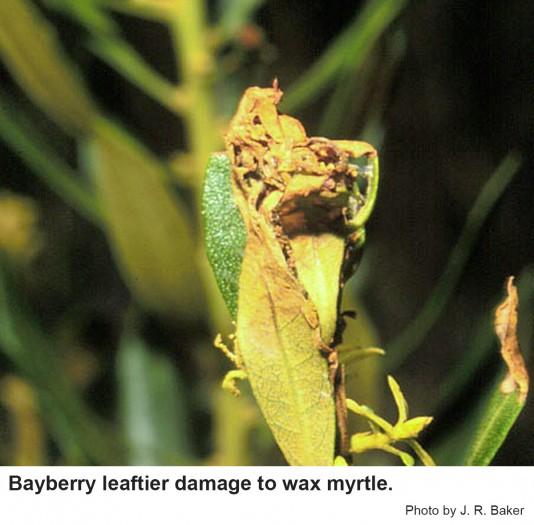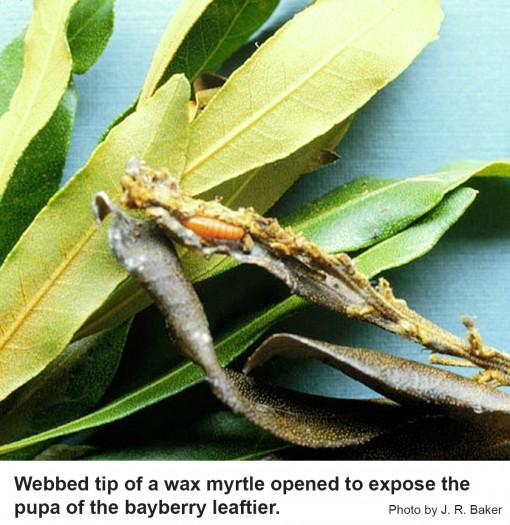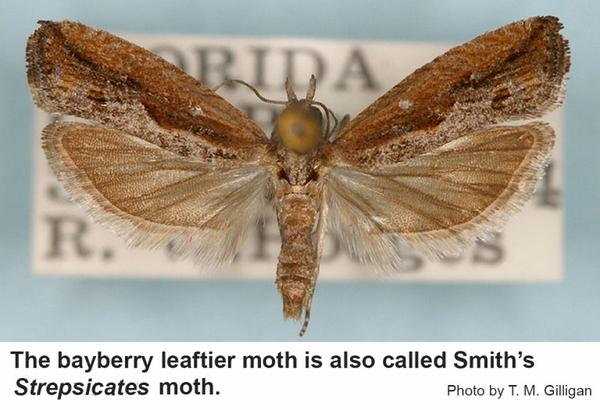Description and Biology
Adult bayberry leaftiers, Strepsicrates smithiana, are sometimes called Smith's Strepsicrates moths. The leaftier stage is a small caterpillar that webs together the terminal growth of wax myrtle and feeds within the webbed leaves. This insect is in the family of leafrollers and it apparently only occurs on wax myrtle in North Carolina (it also infests guava and other species of Myrica all the way down to Chile!). The bayberry leaftier develops through several generations each year as the caterpillars can be found throughout the growing season. The adult is a small, brown, active moth (wingspan about ½ to 5/8 inch) that is not be remarkable among the myriad of other insects in the landscape.
Host Plants
Bayberry leaftiers web together the terminal leaves of wax myrtle and feed within. Wax myrtle is also called southern wax myrtle, southern bayberry, candleberry, bayberry tree, and tallow tree. The tightly webbed foliage becomes even more unsightly as the caterpillars consume the leaves.
Residential Recommendation
Use a systemic insecticide such as Orthene for control of this leaftier caterpillar. Orthene is fairly toxic to caterpillars and is relatively safe for humans. Nurserymen who have used Orthene for Strepsicrates control have been fairly pleased with the results.
References
- Food plant database for the leafrollers of the world (Lepidoptera: Tortricidae) (version 1.0.0). Brown, J. W., G. Robinson and J. A. Powell. 2008. Tortricid.net
- Guava Arthropod Seasonality and Control of Fruit Flies in South Florida. Peña, J. E. et al. 1999. Proc. Fla. State Hort. Soc. 112: 206-209
- Strepsicrates smithiana Walsingham (Lepidoptera, Tortricidae): first record from Chile and a newly documented host plant. Vargas, Héctor A. 2012. Revista Brasileira de Entomologia 56 (3).
- Survey for Potential Biological Control Agents for Myrica faya in the Azores and Madeira. Gardner, D. E., G. P. Markin, and C. S. Hodges, Jr. 1988. Cooperative National Park resources Studis Unit, Univ. of Hawaii at manoa, Dept. of Botany, Honolulu, Hawaii Technical Rept. 63. ii plus 18 pp.
- Extension Plant Pathology Publications and Factsheets
- Horticultural Science Publications
- North Carolina Agricultural Chemicals Manual
For assistance with a specific problem, contact your local N.C. Cooperative Extension Center
This Factsheet has not been peer reviewed.
Publication date: July 4, 2013
Reviewed/Revised: Oct. 9, 2019
Recommendations for the use of agricultural chemicals are included in this publication as a convenience to the reader. The use of brand names and any mention or listing of commercial products or services in this publication does not imply endorsement by NC State University or N.C. A&T State University nor discrimination against similar products or services not mentioned. Individuals who use agricultural chemicals are responsible for ensuring that the intended use complies with current regulations and conforms to the product label. Be sure to obtain current information about usage regulations and examine a current product label before applying any chemical. For assistance, contact your local N.C. Cooperative Extension county center.
N.C. Cooperative Extension prohibits discrimination and harassment regardless of age, color, disability, family and marital status, gender identity, national origin, political beliefs, race, religion, sex (including pregnancy), sexual orientation and veteran status.



